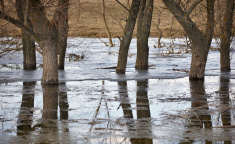Flooding: Information for Homeowners About Private Wells, Sewage and Clean-Up

Flooding wells should be considered contaminated and disinfected before homeowners resume using them.
Those most at risk would include water sources that are in areas where flooding has occurred and is imminent, such as drilled wells located in well pits where groundwater tables have risen in the pit above the top of the well head, and shallow wells or springs located down gradient from open pollution sources such as agricultural or animal waste run-off or nearby septic systems. Other indicators of pollution may include water discoloration or unusual taste or odor to your private water supply.
Homeowners should frequently check their water sources before storms, and shortly after, to make sure that their wells are safe from pollution and possible contamination. If you feel that your water supply may be contaminated, disinfection of the source followed by water sampling (both bacteriological & certain chemical parameters) is encouraged.
You should also contact your local health department or the DPH Private Well Program at (860) 509-8401 for additional advice if necessary. If you notice any unusual changes to the water (color, taste or odor), precautionary measures should be taken such as using bottled water for drinking and cooking until water testing is done to find if contamination is present in the water supply.
For more information about private wells, flooding and the disinfection of wells, please visit the DPH Private Well Program website at www.ct.gov/dph/privatewells or call (860) 509-8401 or send an email to DPH.PrivateWellProgram@ct.gov.
Additional Resources
Information for Homeowners with Private Wells:
-
Video: Well Disinfecting (Penn State University) - 3:40
- Flood and Storm Water Concerns for Private Water Systems
- Disinfection Procedures for Private Wells
- Residential Well Water Testing
- Flood and Storm Water Advisory for Public Water Systems
- CT Laboratories Certified to Test Drinking Water
- EPA flood resources
Information about Sewage:
- Sewage Back-Ups: Information for Residents
- Post Flood: Key Facts About Infectious Disease and Sewage Clean-Up
- After the Storm: Information About Outdoor Clean-Up, Flood Waters Contaminated with Fuel Oil and Sewage
Information About Clean-up After a Flood:
- Creating a Healthy Home: A Field Guide for Clean-Up of Flooded Homes
- After the Storm: What to Do When You Go Back to a Flooded, Moldy Home
- After the Storm: Inspecting for Water Damage
- FEMA - Cleaning Flooded Buildings
- FEMA - Initial Restoration for Flooded Buildings
- EPA - Indoor Air Quality and Floods
Flood Insurance Information:
Other Links:
- CDC: After a Flood
- Preparing for a Flood
- Connecticut Department of Emergency Management and Homeland Security

